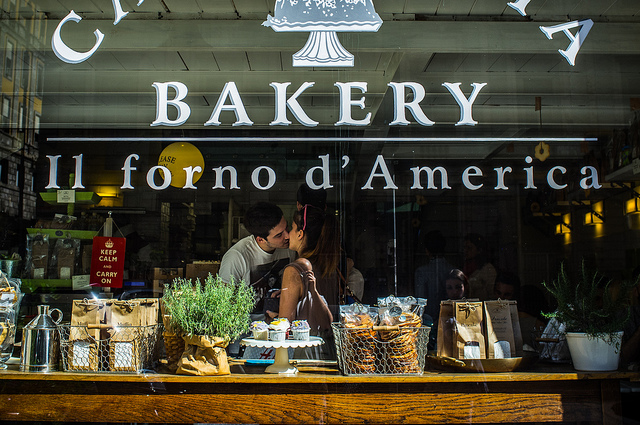Unlock the Magic in Your Story Now
Get the Free 20 questions to Ask Before Launching Your Idea workbook when you sign up for occasional updates.
Get the Free 20 questions to Ask Before Launching Your Idea workbook when you sign up for occasional updates.
Articles filed in: Storytelling
What Are Your Words Designed To Do?
filed in Marketing, Storytelling
 How often have you read website or marketing copy that uses words we’d rarely use in conversation? The real estate agent’s copy describing homes as abodes or residences. The jargon in the consultant’s brochure. The officious tone of the notices in the dentist’s waiting room. We’re often left wondering if the purpose of the language is to confuse when it should be to connect.
How often have you read website or marketing copy that uses words we’d rarely use in conversation? The real estate agent’s copy describing homes as abodes or residences. The jargon in the consultant’s brochure. The officious tone of the notices in the dentist’s waiting room. We’re often left wondering if the purpose of the language is to confuse when it should be to connect.
Before you sit down to craft your marketing messages, it’s worth asking yourself what the words are designed to do. Are you inviting a customer to take action or hoping to persuade a doubtful audience? Are you galvanising your team around a shared goal or getting to know your customers better?
7 Questions To Guide Effective Content Creation
1. What does the audience already know?
2. What does the audience need to know and why?
3. What do you want the audience to do next?
4. What specific language, tone and calls to action do you need to use?
5. Is the copy relevant, clear and credible?
6. What’s the best medium to use in order to reach this audience?
7. How will you measure the effectiveness of your messages?
Clever copy shouldn’t simply make the writer appear smart; it should make the reader feel understood. Words are free, and they are the most potent resource every one of us has access to.
Image by Eka Shoniya.
More Than
filed in Marketing, Storytelling
 In hard-headed, rational commercial environments where tangible advantages are sought in order to make the books balance, we often overlook the value of our products and services being more than commodities. Everything a customer chooses to exchange time, attention or money for says something about who they are. Purchases are forms of self-expression. What we choose to invest in or own is an outward reflection of our internal narrative about who we are and what we value.
In hard-headed, rational commercial environments where tangible advantages are sought in order to make the books balance, we often overlook the value of our products and services being more than commodities. Everything a customer chooses to exchange time, attention or money for says something about who they are. Purchases are forms of self-expression. What we choose to invest in or own is an outward reflection of our internal narrative about who we are and what we value.
The product you’re trying to market is more than the sum of its features and benefits. For example, a car becomes more than a car when it’s part of the driver’s story. The car my husband drives is a ten-year-old, 1.1 litre Yaris with hundreds of kilometres on the clock. We bought it when we moved to Australia and shipped it interstate when we relocated. All three of our boys learned to drive in that little car. For better or worse, I don’t see us parting with the Yaris anytime soon.
The goal of every innovator and marketer is to create the thing that is not just more reliable or useful, but the one that is more meaningful in the life of the customer than he expected it to be.
Image by Bass n’ Roll.
Change Making
filed in Storytelling, Strategy
 The story changes the value.
The story changes the value.
The value changes the perception.
The perception changes the experience.
The experience changes the outcome.
The outcome changes the customer.
The customer changes the story.
Image by Matthias Ripp.
The Power Of Perspective
filed in Storytelling, Success
 The brilliant science graduate had a decade of first class education behind her. But the industry she thought she’d been equipping herself to excel in was experiencing a sudden downturn and her hope of finding the work she had trained to do. Her excellent academic record and transferable skills were worthless in the face of the story she told herself about the future.
The brilliant science graduate had a decade of first class education behind her. But the industry she thought she’d been equipping herself to excel in was experiencing a sudden downturn and her hope of finding the work she had trained to do. Her excellent academic record and transferable skills were worthless in the face of the story she told herself about the future.
Hope impacts our internal narrative, acting like the aperture of a camera’s lens controlling the amount of light reaching the film. It makes us more resourceful, fuels our resilience and strengthens our resolve. We might not have the ability to alter the scene but we can change our perspective.
We have more power to shape our stories than we realise.
Image by Elizabeth Haslam.
Making Your Mark
filed in Entrepreneurship, Storytelling
 Making a mark is not something we talk openly about that much, but it’s something we think about a hell of a lot. From the grandmother who hands down her legendary Christmas pudding recipe, to my Uber driver who, despite having held a managerial position with a big retailer for sixteen years, ‘wants to build something of his own’. From the street artist who feels like he has no voice, to the financial planner who wants to teach the next generation of children how their small actions today can impact their future.
Making a mark is not something we talk openly about that much, but it’s something we think about a hell of a lot. From the grandmother who hands down her legendary Christmas pudding recipe, to my Uber driver who, despite having held a managerial position with a big retailer for sixteen years, ‘wants to build something of his own’. From the street artist who feels like he has no voice, to the financial planner who wants to teach the next generation of children how their small actions today can impact their future.
The fear that we might run out of time to make our mark is one of the reasons we strive to get better at telling our stories. But if the truth is what’s at the heart of all great stories, we can’t begin to make a mark until we acknowledge and articulate what we’re really here to do. Once you’re honest with yourself about the real work you care about and why, you can begin to unapologetically make the mark you hoped to make.
Image by Steffi Lange.
Why Story Sells
filed in Marketing, Storytelling
 The bicycle store owner was walking the customer through the range of helmets that were suitable for her teenage son. He described and demonstrated the features and benefits of three models in various price ranges. The woman seemed unsure and looked for a moment like she was about to leave with a promise to come back when she’d thought about it.
The bicycle store owner was walking the customer through the range of helmets that were suitable for her teenage son. He described and demonstrated the features and benefits of three models in various price ranges. The woman seemed unsure and looked for a moment like she was about to leave with a promise to come back when she’d thought about it.
There was no hard sell from the owner who took out his smartphone while they were chatting to show her what the mid-range helmet looked like in the flesh. He and his teenage son had just returned from a cycle tour. His son was wearing the $159 helmet in the photos. And just like that, her mind was made up.
“If you think it’s good enough for your son, then it must be good enough for mine,” she said.
We don’t just want to be persuaded; we want to believe—which is why it’s not enough to sell to the head when people buy with their hearts.
Image by thejuniorpartner.
The Genuine Article
filed in Storytelling
 When I was a child growing up in Dublin the biggest compliment you could pay someone was to say they were ‘the genuine article’. Sincerity was something to aspire to, and we witnessed it daily in people’s actions and words.
When I was a child growing up in Dublin the biggest compliment you could pay someone was to say they were ‘the genuine article’. Sincerity was something to aspire to, and we witnessed it daily in people’s actions and words.
In our carefully curated, photoshopped and filtered world, we are more drawn to the genuine than ever. It’s the quality we most want our institutions, our communities and our leaders to embody. And yet we sometimes forget, that like most things we want to influence or change, it starts with us.
Our challenge is to go beyond saying it like we mean it.
We need to practice being it so that others can feel it.
Image by Jody Sticca.
How To Tell A Brand Story Customers Believe In
filed in Marketing, Storytelling
 It was a slow Wednesday morning, and the smell of freshly baked croissants wafted from the new French bakery. The store was almost empty, as were the display cabinets that should have been teeming with tempting pastries at this hour. The rock music blared. The bakery assistant who wore yesterday’s apron and a half-hearted smile, dropped the croissant she was bagging while remarking to a colleague that running out of croissants was ‘not a good look for a French bakery’. She haphazardly sealed the bag by scrunching the top with her fist. The customer paid $4.90 for the croissant. His coffee was half price because of a special promotion the bakery was running to attract more customers before 9.30am. What should have been a story about an exceptional croissant worth paying almost $5 for was broken because of the mediocre experience.
It was a slow Wednesday morning, and the smell of freshly baked croissants wafted from the new French bakery. The store was almost empty, as were the display cabinets that should have been teeming with tempting pastries at this hour. The rock music blared. The bakery assistant who wore yesterday’s apron and a half-hearted smile, dropped the croissant she was bagging while remarking to a colleague that running out of croissants was ‘not a good look for a French bakery’. She haphazardly sealed the bag by scrunching the top with her fist. The customer paid $4.90 for the croissant. His coffee was half price because of a special promotion the bakery was running to attract more customers before 9.30am. What should have been a story about an exceptional croissant worth paying almost $5 for was broken because of the mediocre experience.
Where did the bakery go wrong and how could they tell a better brand story? The biggest problem is the disconnect between their desire to pitch their product as a premium offering and supporting that story with nothing more than quality ingredients and high prices. The service design and delivery tells a different story. The empty display cabinets, discounting, poorly trained and presented staff and music that doesn’t enhance the mood, create a disconnect.
Our brand stories are not merely a way to get customers to come through the door and hand over cash—we want them to feel glad that they did. Every choice we make and everything we do must align with the story we want our brand to embody. Our actions have to support the message we want customers to believe.
The product, environment, service, and design each play a part in taking our customers on a journey we hope they’ll want to repeat. It’s our job to make sure the story is consistent from start to finish. We do that by being clear about exactly what our brand stands for and by making deliberate decisions that align with and support that vision.
Image by Emanuele Toscano.
The Forgotten Power And Purpose Of Story
filed in Marketing, Storytelling
 As business leaders and entrepreneurs, our motivations for understanding the power of story are clear—we want to create compelling narratives so more people will hear, believe and buy into our stories. We know we can use story to inform, educate, entertain, inspire and importantly, persuade people. We leverage story to perform valuable sales and marketing functions in our businesses.
As business leaders and entrepreneurs, our motivations for understanding the power of story are clear—we want to create compelling narratives so more people will hear, believe and buy into our stories. We know we can use story to inform, educate, entertain, inspire and importantly, persuade people. We leverage story to perform valuable sales and marketing functions in our businesses.
According to Bloomberg, in the dying days of the recent U.S. Presidential election, the two campaigns spent a combined total of $44.5 million on TV advertising in battleground states attempting to persuade voters to believe their story. Overall the Clinton campaign spent $137 million more than the Trump campaign on TV advertising during the 21 weeks leading up to the election. As we know, it wasn’t enough to ensure victory.
As marketers, we understand that now more than ever our potential audience can tune out when they want to, and so we leverage every channel we have to find new ways to make them listen. The irony is that while we’ve doubled down on ‘telling’ we’ve neglected the opportunity to use story as a discovery tool—we’ve forgotten the importance of actually listening to the stories of the people we want to serve.
If we deeply understand the stories of the people we hope to convince we have a better chance of telling a story they want to hear. But more important than that—we get the opportunity to put their interests at the heart of everything we do. Imagine the difference we could create if we invested as much in trying to understand as we do on trying to be heard.
Image by Francis McKee.
 My husband, who is a doctor has been trialling ways to improve the patient experience at the practice where he works one day a week. There are many things about the experience that are out of his control. He can’t control how the receptionist speaks to the patient on arrival, cut the waiting time or shush crying babies in the waiting room. But there are moments in between where he can have an impact.
My husband, who is a doctor has been trialling ways to improve the patient experience at the practice where he works one day a week. There are many things about the experience that are out of his control. He can’t control how the receptionist speaks to the patient on arrival, cut the waiting time or shush crying babies in the waiting room. But there are moments in between where he can have an impact.